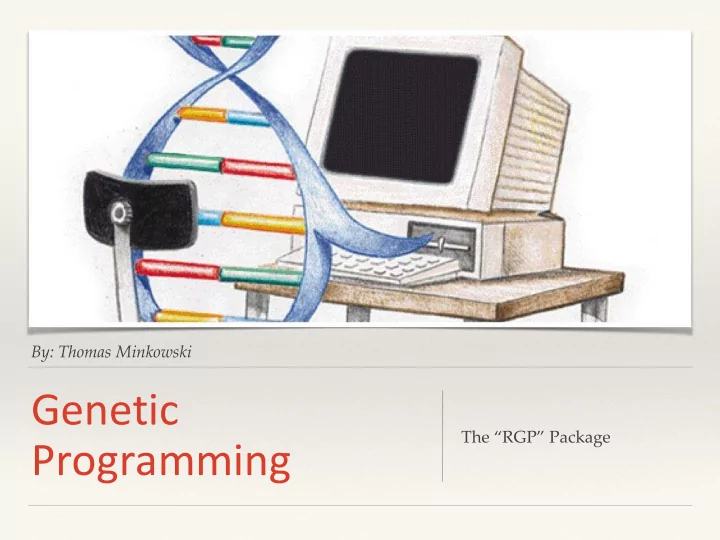

By: Thomas Minkowski Genetic The “RGP” Package Programming
Contents ❖ Theory of Evolution ❖ Evolutionary Computation ❖ Genetic Algorithms ❖ GA Operators ❖ RGP Package Overview ❖ RGP Package Operators ❖ Symbolic Regression ❖ Experiment 1 ❖ Experiment 2
Theory of Evolution ❖ All life is related and has descended from a common ancestor ❖ Genetic mutations ❖ Survival of the Fittest ❖ Reproduction ❖ The result is an organism more fit for their environment
Evolutionary Computation ❖ Field that uses algorithms inspired by the Theory of Evolution, known as evolutionary algorithms. ❖ uses trial-and-error problem solving optimization methods
Genetic Algorithms ❖ Most popular type of Evolutionary Algorithm ❖ Uses the ideas of biological evolution to come up with solutions ❖ Reproduction, Mutation, crossover and Recombination
Genetic Algorithms and Darwinian Evolution ❖ Candidate Solutions - Individuals in the population ❖ Fitness Function - Environment ❖ GA Operators - Reproduction, crossover, and Mutation
Genetic Algorithm Flow
GA Operators ❖ Reproduction ❖ Crossover ❖ Mutation
Reproduction Generation 1 Generation 2
Crossover
Mutation
RGP Package in R ❖ Genetic Programming package for R. ❖ Genetic Programming uses genetic algorithms, but the individuals are represented as programs ❖ These individuals, or programs, are represented through R expressions ❖ Tree-based structure
RGP Package Operators ❖ The operators have default values, but the programmer has a large degree of control over them. ❖ Initiation - How the initial trees are created ❖ Variation - How the individuals are manipulated ❖ Selection - Controls which individuals are selected for the next generation
Symbolic Regression ❖ Searches mathematical expressions to find a model that fits the dataset, in terms of both accuracy and simplicity. ❖ Uses Genetic Programming, so there is no defined starting point. ❖ Differs from classical regression because there is no pre- defined model, leaving the model to be created by the genetic algorithms.
Symbolic Regression Experiment 1 ❖ This experiment uses the RGP package to create a polynomial expression that attempts to fit the sin function.
Experiment 1 steps 1. Define the search space. 1. Function Symbols (+, -, *) 2. Variables (x) 3. Constants (using random constants from a normal distributiobution) 2. Define the fitness function. 1. Fitness Function is set to the sin function over a certain interval. 3. Run the geneticProgramming() function 1. Allow the GP to run for 5 minutes. 4. Determine the fittest individual 5. Plot the result against the sin function to compare.
Experiment 1 Results
Symbolic Regression Experiment 2 ❖ Using a formula that represents a damped pendulum, create data from it and use the symbolicRegression() function to create a model of the data, which will be compared to the formula for the pendulum.
Experiment 2 Steps 1. Make a function representing a damped pendulum. 2. Use the created function to create a specific pendulum that will be used to gather data from. 3. Create data of 512 samples of a pendulum over a certain time interval. 1. Add normally distributed noise to the data to simulate real measurements. 4. Run the symbolicRegression() function with a time constraint of 2 minutes. • (Since a polynomial isn't required, the search space doesn't need to be limited to addition, subtraction and multiplication) 5. Store the fittest model. 6. Plot the result against the pendulum function and compare.
Experiment 2 Results
Recap ❖ Theory of Evolution ❖ Evolutionary Computation ❖ Genetic Algorithms ❖ GA Operators ❖ RGP Package Overview ❖ RGP Package Operators ❖ Symbolic Regression ❖ Experiment 1 ❖ Experiment 2
Questions?
Bibliography Flasch, Oliver. "A Friendly Introduction to RGP." Environmentally-Friendly Product Development (n.d.): n. pag. CRAN R Project. RSymbolic Project, 7 Aug. 2014. Web. 1Dec. 2016. <https://cran.r- project.org/web/packages/rgp/vignettes/rgp_introduction.pdf>. Holland, John H. "Genetic Algorithms - John H. Holland." Genetic Algorithms - John H. Holland. N.p., n.d. Web. 10 Oct. 2016. "Darwin's Theory Of Evolution." Darwin's Theory Of Evolution. All About Science, n.d. Web. 10 Oct. 2016. Fogel, David B. Evolutionary Computation: Toward a New Philosophy of Machine Intelligence. New York: IEEE, 1995. Print. Heitkotter, Jorg, and David Beasley. "The Hitch-Hiker's Guide to Evolutionary Computation." Hitch- Hiker's Guide to Evolutionary Computation. N.p., 12 Apr. 2001. Web. 10 Oct. 2016. Koza, John R. "Genetic Programming." Genetic-programming.org-Home-Page. N.p., 8 July 2007. Web. 10 Oct. 2016.
Recommend
More recommend